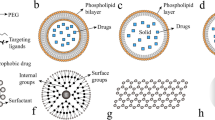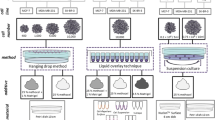Abstract
Tumor spheroids are three-dimensional clusters of cancer cells that exhibit characteristics of poorly perfused tumors and hence present a relevant model for testing the efficacy of anti-cancer compounds. The use of spheroids for drug screening is hindered by technological complexities for high throughput generation of consistent size spheroids individually addressable by drug compounds. Here we present and optimize a simple spheroid technology based on the use of an aqueous two-phase system. Cancer cells confined in a drop of the denser aqueous dextran phase are robotically dispensed into a microwell containing the immersion aqueous polyethylene glycol phase. Cells remain within the drop and form a viable spheroid, without a need for any external stimuli. The size of resulting spheroids is sensitive to volume variations of dispensed drops from the air displacement pipetting head of a commercial liquid handling robot. Therefore, we parametrically optimize the process of dispensing of dextran phase drops. For a given cell density, this optimization reproducibly generates consistent size spheroids in standard 96-well plates. In addition, we evaluate the use of a commercial biochemical assay to examine cellular viability of cancer cell spheroids. Spheroids show a dose-dependent response to cisplatin similar to a monolayer culture. However unlike their two-dimensional counterpart, spheroids exhibit resistance to paclitaxel treatment. This technology, which uses only commercially-available reagents and equipment, can potentially expedite anti-cancer drug discovery. Although the use of robotics makes the ATPS spheroid technology particularly useful for drug screening applications, this approach is compatible with simpler liquid handling techniques such as manual micropipetting and offers a straightforward method of 3D cell culture in research laboratories.





Similar content being viewed by others
Abbreviations
- ATPS:
-
Aqueous two-phase system
- 3D:
-
Three-dimensional
- PEG:
-
Polyethylene glycol
- DEX:
-
Dextran
- CCS:
-
Cancer cell spheroids
References
Albertsson, P.-A., and F. Tjerneld. Phase diagrams. Methods Enzymol. 228:3–13, 1994.
Andre, F., and C. C. Zielinski. Optimal strategies for the treatment of metastatic triple-negative breast cancer with currently approved agents. Ann. Oncol. 23(Suppl 6):46–51, 2012.
Atefi, E., S. Lemmo, D. Fyffe, G. D. Luker, and H. Tavana. High throughput, polymeric aqueous two-phase printing of tumor spheroids. Adv. Func. Mater. 2014, in press (doi:10.1002/adfm.201401302).
Blum, J. L., V. Dieras, P. M. Lo Russo, J. Horton, O. Rutman, et al. Multicenter, phase II study of capecitabine in taxane-pretreated metastatic breast carcinoma patients. Cancer 92:1759–1768, 2001.
Byrski, T., T. Huzarski, R. Dent, J. Gronwald, D. Zuziak, et al. Response to neoadjuvant therapy with cisplatin in BRCA1-positive breast cancer patients. Breast Cancer Res. Treat. 115:359–363, 2009.
Carlsson, J., and J. M. Yuhas. Liquid-overlay culture of cellular spheroids. Rec. Results Cancer Res. 95:1–23, 1984.
Chen, H., S. A. Quandt, J. G. Grzywacz, and T. A. Arcury. A distribution-based multiple imputation method for handling bivariate pesticide data with values below the limit of detection. Environ. Health Persp. 119:351–356, 2011.
Comerford, K. M., T. J. Wallace, J. Karhausen, N. A. Louis, M. C. Montalto, and S. P. Colgan. Hypoxia-inducible factor-1-dependent regulation of the multidrug resistance (MDR1) gene. Cancer Res. 62:3387–3394, 2002.
Corey, J. M., C. C. Gertz, T. J. Sutton, Q. Chen, K. B. Mycek, et al. Patterning N-type and S-type neuroblastoma cells with Pluronic F108 and ECM proteins. J. Biomed. Mater. Res. A 93:673–686, 2010.
Desoize, B., and J. Jardillier. Multicellular resistance: a paradigm for clinical resistance? Crit. Rev. Oncol. Hematol. 36:193–207, 2000.
Desplats, P., B. Spencer, L. Crews, P. Pathel, D. Morvinski-Friedmann, et al. Alpha-synuclein induces alterations in adult neurogenesis in Parkinson disease models via p53-mediated repression of Notch1. J. Biol. Chem. 287:31691–31702, 2012.
Frankel, A., R. Buckman, and R. S. Kerbel. Abrogation of taxol-induced G2-M arrest and apoptosis in human ovarian cancer cells grown as multicellular tumor spheroids. Cancer Res. 57:2388–2393, 1997.
Friedrich, J., C. Seidel, R. Ebner, and L. A. Kunz-Schughart. Spheroid-based drug screen: considerations and practical approach. Nat. Protoc. 4:309–324, 2009.
Ghajar, C. M., and M. J. Bissell. Tumor engineering: the other face of tissue engineering. Tissue Eng. A 16:2153–2156, 2010.
Hirschhaeuser, F., H. Menne, C. Dittfeld, J. West, W. Mueller-Klieser, and L. A. Kunz-Schughart. Multicellular tumor spheroids: an underestimated tool is catching up again. J. Biotechnol. 148:3–15, 2010.
Holder, J. W., E. Elmore, and J. C. Barrett. Gap junction function and cancer. Cancer Res. 53:3475–3485, 1993.
Hsiao, A. Y., Y. C. Tung, C. H. Kuo, B. Mosadegh, R. Bedenis, et al. Micro-ring structures stabilize microdroplets to enable long term spheroid culture in 384 hanging drop array plates. Biomed. Microdev. 14:313–323, 2012.
Hutmacher, D. W., D. Loessner, S. Rizzi, D. L. Kaplan, D. J. Mooney, and J. A. CClements. Can tissue engineering concepts advance tumor biology research? Trends Biotechnol. 28:125–133, 2010.
Kelm, J. M., N. E. Timmins, C. J. Brown, M. Fussenegger, and L. K. Nielsen. Method for generation of homogeneous multicellular tumor spheroids applicable to a wide variety of cell types. Biotechnol. Bioeng. 83:173–180, 2003.
Kenny, P. A., G. Y. Lee, C. A. Myers, R. M. Neve, J. R. Semeiks, et al. The morphologies of breast cancer cell lines in three-dimensional assays correlate with their profiles of gene expression. Mol. Oncol. 1:84–96, 2007.
Kerbel, R. S., B. St Croix, V. A. Florenes, and J. Rak. Induction and reversal of cell adhesion-dependent multicellular drug resistance in solid breast tumors. Hum. Cell 9:257–264, 1996.
Kim, T., I. Doh, and Y. H. Cho. On-chip three-dimensional tumor spheroid formation and pump-less perfusion culture using gravity-driven cell aggregation and balanced droplet dispensing. Biomicrofluidics 6:34107, 2012.
Kobayashi, H., S. Man, C. H. Graham, S. J. Kapitain, B. A. Teicher, and R. S. Kerbel. Acquired multicellular-mediated resistance to alkylating agents in cancer. PNAS 90:3294–3298, 1993.
Lemmo, S., S. Nasrollahi, and H. Tavana. Aqueous biphasic cancer cell migration assay enables robust, high-throughput screening of anti-cancer compounds. Biotechnol. J. 9:426–434, 2014.
Mehta, G., A. Y. Hsiao, M. Ingram, G. D. Luker, and S. Takayama. Opportunities and challenges for use of tumor spheroids as models to test drug delivery and efficacy. J. Control. Release 164:192–204, 2012.
Mueller-Klieser, W. Three-dimensional cell cultures: from molecular mechanisms to clinical applications. Am. J. Physiol. 273:C1109–C1123, 1997.
Napolitano, A. P., D. M. Dean, A. J. Man, J. Youssef, D. N. Ho, et al. Scaffold-free three-dimensional cell culture utilizing micromolded nonadhesive hydrogels. BioTechniques 43(494):96–500, 2007.
Olive, P. L., and R. E. Durand. Drug and radiation resistance in spheroids: cell contact and kinetics. Cancer Metast. Rev. 13:121–138, 1994.
Petrak, D., E. Atefi, L. Yin, W. Chilian, and H. Tavana. Automated, spatio-temporally controlled cell microprinting with polymeric aqueous biphasic system. Biotechnol. Bioeng. 11:404–412, 2014.
Rivera, E., and H. Gomez. Chemotherapy resistance in metastatic breast cancer: the evolving role of ixabepilone. Breast Cancer Res. 12(Suppl 2):S2, 2010.
Seano, G., G. Chiaverina, P. A. Gagliardi, L. di Blasio, R. Sessa, et al. Modeling human tumor angiogenesis in a three-dimensional culture system. Blood 121:e129–e137, 2013.
Silver, D. P., A. L. Richardson, A. C. Eklund, Z. C. Wang, Z. Szallasi, et al. Efficacy of neoadjuvant cisplatin in triple-negative breast cancer. J. Clin. Oncol. 28:1145–1153, 2010.
Souza, G. R., J. R. Molina, R. M. Raphael, M. G. Ozawa, D. J. Stark, et al. Three-dimensional tissue culture based on magnetic cell levitation. Nat. Nanotechnol. 5:291–296, 2010.
Sutherland, R. M., J. A. McCredie, and W. R. Inch. Growth of multicell spheroids in tissue culture as a model of nodular carcinomas. J. Nat. Cancer Inst. 46:113–120, 1971.
Tavana, H., A. Jovic, B. Mosadegh, Q. Y. Lee, X. Liu, et al. Nanolitre liquid patterning in aqueous environments for spatially defined reagent delivery to mammalian cells. Nat. Mater. 8:736–741, 2009.
Tavana, H., B. Mosadegh, and S. Takayama. Polymeric aqueous biphasic systems for non-contact cell printing on cells: engineering heterocellular embryonic stem cell niches. Adv. Mater. 22:2628–2631, 2010.
Tavana, H., B. Mosadegh, P. Zamankhan, J. B. Grotberg, and S. Takayama. Microprinted feeder cells guide embryonic stem cell fate. Biotechnol. Bioeng. 108:2509–2516, 2011.
Tavana, H., K. Kaylan, T. Bersano-Begey, K. E. Luker, G. D. Luker, and S. Takayama. Polymeric aqueous biphasic system rehydration facilitates high throughput cell exclusion patterning for cell migration studies. Adv. Funct. Mater. 21:2920–2926, 2011.
Tekin, H., M. Anaya, M. D. Brigham, C. Nauman, R. Langer, and A. Khademhosseini. Stimuli-responsive microwells for formation and retrieval of cell aggregates. Lab Chip 10:2411–2418, 2010.
Thode, H. C. Testing for normality. New York: CRC Press, 2002.
Torisawa, Y. S., B. Mosadegh, G. D. Luker, M. Morell, K. S. O’Shea, and S. Takayama. Microfluidic hydrodynamic cellular patterning for systematic formation of co-culture spheroids. Integr. Biol. 1:649–654, 2009.
Tung, Y. C., A. Y. Hsiao, S. G. Allen, Y. S. Torisawa, M. Ho, and S. Takayama. High-throughput 3D spheroid culture and drug testing using a 384 hanging drop array. Analyst 136:473–478, 2011.
Vinci, M., S. Gowan, F. Boxall, L. Patterson, M. Zimmermann, et al. Advances in establishment and analysis of three-dimensional tumor spheroid-based functional assays for target validation and drug evaluation. BMC Biol. 10:29, 2012.
Wartenberg, M., F. Donmez, F. C. Ling, H. Acker, J. Hescheler, and H. Sauer. Tumor-induced angiogenesis studied in confrontation cultures of multicellular tumor spheroids and embryoid bodies grown from pluripotent embryonic stem cells. FASEB J. 15:995–1005, 2001.
Wong, E. Y., and S. L. Diamond. Advancing microarray assembly with acoustic dispensing technology. Anal. Chem. 81:509–514, 2009.
Xie, J., D. W. Li, X. W. Chen, F. Wang, and P. Dong. Expression and significance of hypoxia-inducible factor-1alpha and MDR1/P-glycoprotein in laryngeal carcinoma tissue and hypoxic Hep-2 cells. Oncol. Lett. 6:232–238, 2013.
Xie, Z., L. Cao, and J. Zhang. miR-21 modulates paclitaxel sensitivity and hypoxia-inducible factor-1alpha expression in human ovarian cancer cells. Oncol. Lett. 6:795–800, 2013.
Yamada, K. M., and E. Cukierman. Modeling tissue morphogenesis and cancer in 3D. Cell 130:601–610, 2007.
Acknowledgements
This work is supported by a Grant from the National Institutes of Health R21CA182333.
Conflict of interest
Stephanie Lemmo, Ehsan Atefi, Gary D. Luker, and Hossein Tavana declare that they have no conflict of interest.
Ethical Standards
This work involved no human subjects or animal studies.
Author information
Authors and Affiliations
Corresponding author
Additional information
Associate Editor Cynthia A. Reinhart-King oversaw the review of this article.
This paper is part of the 2014 Young Innovators Issue.
This paper is part of the 2014 Young Innovators Issue.
Electronic supplementary material
Below is the link to the electronic supplementary material.
Rights and permissions
About this article
Cite this article
Lemmo, S., Atefi, E., Luker, G.D. et al. Optimization of Aqueous Biphasic Tumor Spheroid Microtechnology for Anti-cancer Drug Testing in 3D Culture. Cel. Mol. Bioeng. 7, 344–354 (2014). https://doi.org/10.1007/s12195-014-0349-4
Received:
Accepted:
Published:
Issue Date:
DOI: https://doi.org/10.1007/s12195-014-0349-4




